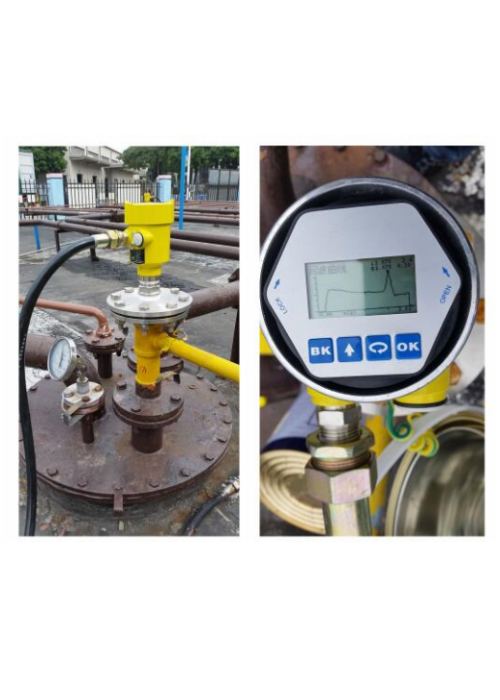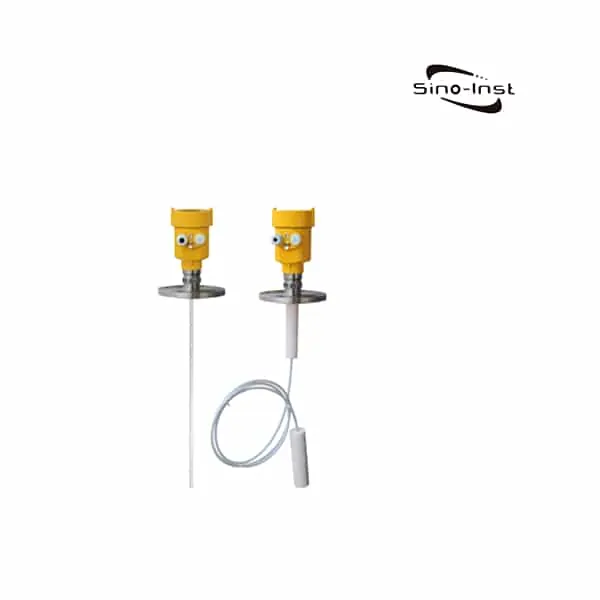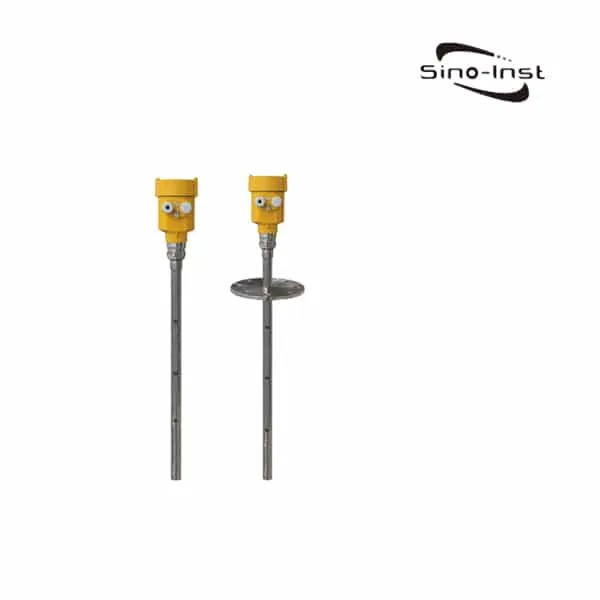The guided wave radar level transmitter is suitable for small range storage tanks, complex tanks with geometric shapes and internal obstacles. Suitable for applications with steam, buildup, foaming, condensation.
After the microwave pulse is guided down the probe to reach the material, part of the signal is reflected back, and the material level is obtained by measuring the time difference between the signal transmission and reception.
In actual use, we may encounter some inaccurate measurements. Next, we introduce guided wave radar level transmitter calibration and troubleshooting. Hope it works for you.

Guided Wave Radar Level Transmitter Calibration
- Through the HART handheld programmer. However, the HART handheld programmer has its adjustment range. It is not applicable to all products. The combined measurement range is the corresponding value of 4-20mA.
- Adjust the module by hand. Its function is equivalent to an analysis and processing instrument. The programmer consists of keys and an LCD display. Adjustment menus and parameter settings can be displayed.
- By debugging the software. The guided wave radar level transmitter can be debugged through software.
The process is: mainly use HART software for debugging. A meter driver is required. Among them, when using software debugging, power up the radar instrument with 24VDC. At the same time, add a 250 ohm resistor to the front end of the HART adapter. If the instrument is powered by an integrated HART resistor, that is, the internal resistance is 250 ohms, no additional external resistance is required. At this time, the HART adapter can be connected in parallel with the 4–20mA line.
The above are relatively common debugging methods and means for guided wave radar level transmitters. You can correspond to your actual situation and judge the most suitable method for you to use. Do it last. Remember to be careful when choosing a method, otherwise errors are prone to occur.
Guided Wave Radar Level Transmitter Troubleshooting
Guided Wave Radar Level Transmitter has many advantages in the level meter field. It generally adopts an integrated design, no moving parts, no mechanical wear, and long service life. And it can be used for level measurement of almost all liquids. However, in the process of use, there will still be inaccurate measurements. What’s the matter?
- Probe scarring and frequent failures
Solution: The first solution is to increase the installation position of the Guided Wave Radar Level Transmitter probe. However, if the installation condition is limited and cannot be increased, the method of interlocking the liquid level measurement value with the pump of the tank can be used to solve the problem. This problem. Reduce the maximum liquid level set value by about 0.5m. When the liquid level reaches the maximum value, you can stop or start the discharge pump.
- The effect of foam on measurement
Solution: Both dry foam and wet foam can reflect the radar wave of the Guided Wave Radar Level Transmitter, which has no effect on the measurement. But neutral foam absorbs and diffuses radar waves. Reflections that seriously affect echoes or even no echoes.
Therefore, when the surface of the medium is dense and thick foam, the measurement error of the Guided Wave Radar Level Transmitter will be large or impossible to measure. It is recommended to replace other suitable type of level meter.

- Antenna scarring
Solution: The hanging material with a small dielectric constant has no effect on the measurement in a dry state. However, the hanging material with a high dielectric constant will affect the measurement. Blowing with compressed air (or flushing with clean water) is recommended, and cooled compressed air can reduce the temperature of flanges and electrical components. Although alkaline scabs can also be cleaned with an acidic cleaning solution, level measurements cannot be taken during cleaning. More about Advantages of Coaxial Probes.
- Guided Wave Radar Level Transmitter antenna flooded
Solution: Change Guided Wave Radar Level Transmitter to waveguide measurement.
Install the Guided Wave Radar Level Transmitter at the original opening, and the waveguide is about 0.2m higher than the exhaust pipe. In this way, even if there is a bad working condition where the slurry overflows from the exhaust pipe, the level meter antenna will not be damaged The slurry is submerged. And it will not cause the disturbance of the stirrer vortex and a large amount of steam from the probe, which reduces the damage to the probe.
In addition, due to the better focusing effect of the waveguide, the received radar wave signal will be stronger. Therefore, better measurement results can be obtained.
The above content is for reference only. Of course, there are other reasons for the inaccurate measurement of the Guided Wave Radar Level Transmitter, which needs to be checked in combination with the actual situation.
Featured Guided Wave Radar Level Transmitters
More about Guided Wave Radar Level Transmitter technology and application:
- Guided-wave radar (GWR) level transmitter working principle
- Influence of Dielectric Constant on Guided Wave Radar Level Meter
- Guided wave radar level transmitter measures drum level
What is the difference between radar and guided wave radar level transmitter?
- Different ways of contact:
Radar level gauges are non-contact. Guided wave level gauge is contact type. That is to say, the guided wave type cannot be used in occasions with high food grade requirements. - Different working media:
The guided wave radar level gauge also needs to consider the corrosiveness and adhesion of the medium. Moreover, the installation and maintenance of guided wave radars that are too long are more difficult.
In the case of low permittivity, the measuring principle of radar or guided wave radar is based on the difference in permittivity. Since the waves emitted by ordinary radar are divergent, when the dielectric constant is too low, the signal is too weak to measure stably. Guided wave radar waves propagate along the probe, and the signal is relatively stable. - Different types of selection:
Ordinary radar can be used interchangeably. Guided wave radar cannot be used interchangeably because the probe (cable) has a fixed length according to the original working conditions. The selection of guided wave radar is more troublesome than ordinary radar. - Different ranging:
Ordinary radar is mostly used on 30 and 40m tanks, and can even measure to 150m. Guided wave radar also needs to consider the force of the probe (cable). It is precisely because of the force that the measurement distance of guided wave radar is generally not very long.
However, guided wave radar has obvious advantages in special working conditions such as stirring in the tank and large fluctuations in the medium. The measured value of the guided wave radar fixed at the bottom of this working condition is more stable than that of the flexible radar. And small tanks. For liquid level measurement, due to the small installation and measurement space (or a lot of interference in the tank), general radar is not applicable, and the advantages of guided wave radar are reflected at this time.
More Tank Level Measurement Solutions
Guided wave radar level transmitter uses guided wave radar (GWR) technology. Based on the reflection of microwave on the surface medium. Through the probe, continuous level measurement of liquid and solid levels is completed.
Guided Wave Radar Level Transmitter has an absolute advantage in solid working conditions. for example:
- If there is stirring in the tank and the medium fluctuates greatly, the measured value of the guided wave radar fixed at the bottom is more stable than that of ordinary radar;
- Level measurement in small tanks.
- Working conditions with low dielectric constant.
- The general guided wave radar also has a bottom detection function, which can be corrected according to the measured value of the bottom echo signal to make the signal more stable and accurate.
Sino-Inst offers over 10 GWR Corrosive Liquid Chemical Level Sensors for level measurement. About 50% of these are Guided Radar level meters, 40% is the tank level sensor.
A wide variety of GWR Corrosive Liquid Chemical Level Sensors options are available to you, such as free samples, paid samples.
Sino-Inst is a globally recognized supplier and manufacturer of Guided Wave radar level measurement instrumentation, located in China.
Request a Quote

Wu Peng, born in 1980, is a highly respected and accomplished male engineer with extensive experience in the field of automation. With over 20 years of industry experience, Wu has made significant contributions to both academia and engineering projects.
Throughout his career, Wu Peng has participated in numerous national and international engineering projects. Some of his most notable projects include the development of an intelligent control system for oil refineries, the design of a cutting-edge distributed control system for petrochemical plants, and the optimization of control algorithms for natural gas pipelines.







